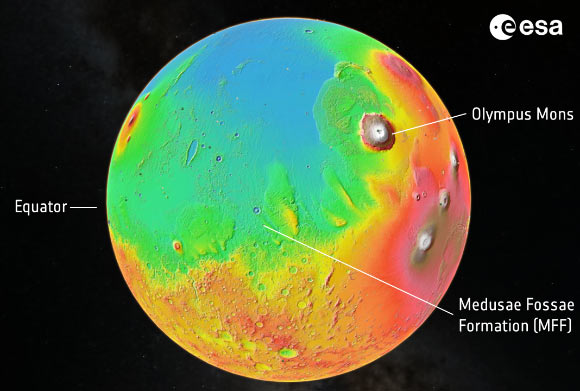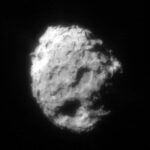Over 15 years ago, ESA’s Mars Express spacecraft studied the Medusae Fossae Formation, revealing enigmatic deposits up to 2.5 km deep. From those early observations, it was unclear what the deposits were made of, but the new research has an answer.
This image shows a height map of the Martian surface, with lowest land in blue and highest in white. Image credit: ESA.
The Medusae Fossae Formation (MFF) — a massive, unusual deposit of soft rock near Mars’ equator — is about one-fifth as large as the continental United States and 100 times more massive than the largest explosive volcanic deposit on Earth.
It consists of several wind-sculpted features measuring hundreds of km across and several km high.
Found at the boundary between the Martian highlands and lowlands, the features are possibly the biggest single source of dust on Mars.
Initial observations from ESA’s Mars Express spacecraft showed the MFF to be relatively transparent to radar and low in density, both characteristics we’d see from icy deposits.
However, planetary scientists couldn’t rule out a drier possibility: that the features are actually giant accumulations of windblown dust, volcanic ash or sediment.
“We’ve explored the MFF again using newer data from Mars Express’ MARSIS radar, and found the deposits to be even thicker than we thought: up to 3.7 km thick,” said Dr. Thomas Watters, a planetary researcher at Smithsonian Institution.
“Excitingly, the radar signals match what we’d expect to see from layered ice, and are similar to the signals we see from Mars’ polar caps, which we know to be very ice rich.”
“If melted, the ice locked up in the MFF would cover the entire planet in a layer of water 1.5 to 2.7 m deep: the most water ever found in this part of Mars, and enough to fill Earth’s Red Sea.”
“Here’s where the new radar data comes in! Given how deep it is, if the MFF was simply a giant pile of dust, we’d expect it to become compacted under its own weight,” said Dr. Andrea Cicchetti, a researcher at the National Institute for Astrophysics in Italy.
“This would create something far denser than what we actually see with MARSIS.”
“And when we modeled how different ice-free materials would behave, nothing reproduced the properties of the MFF — we need ice.”
“The new results instead suggest layers of dust and ice, all topped by a protective layer of dry dust or ash several hundred meters thick.”

In this image, the white line on Mars’ surface (top) shows a stretch of land that was scanned by Mars Express’ MARSIS radar. The graph below shows the shape of the land and the structure of the subsurface, with the layer of dry sediments (likely dust or volcanic ash) in brown and the layer of suspected ice-rich deposits in blue. The graph shows that the ice deposit is thousands of meters high and hundreds of km wide. If all the suspected water ice in the MFF melted, it would cover Mars in an ocean of water up to 2.7 m deep. Image credit: CReSIS / KU / Smithsonian Institution.
“This latest analysis challenges our understanding of the MFF, and raises as many questions as answers,” said Dr. Colin Wilson, ESA project scientist for Mars Express and the ESA ExoMars Trace Gas Orbiter.
“How long ago did these ice deposits form, and what was Mars like at that time?”
“If confirmed to be water ice, these massive deposits would change our understanding of Mars climate history.”
“Any reservoir of ancient water would be a fascinating target for human or robotic exploration.”
The results will be published in the journal Geophysical Research Letters.
_____
Thomas Watters et al. 2024. Evidence of Ice-Rich Layered Deposits in the Medusae Fossae Formation of Mars. Geophysical Research Letters, in press;




